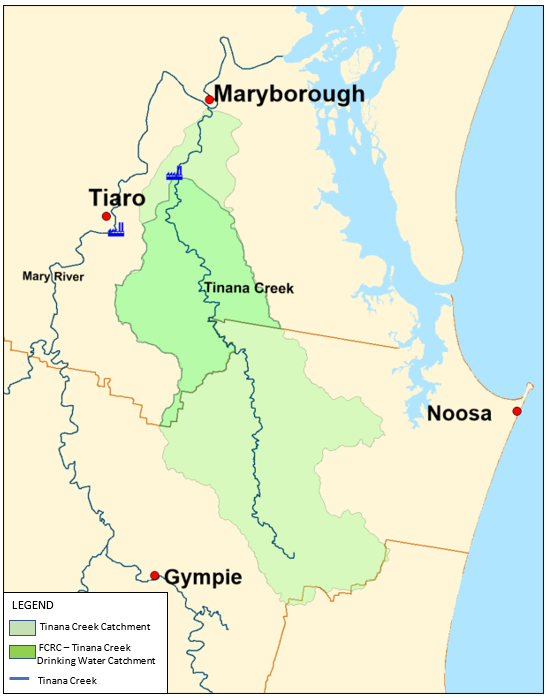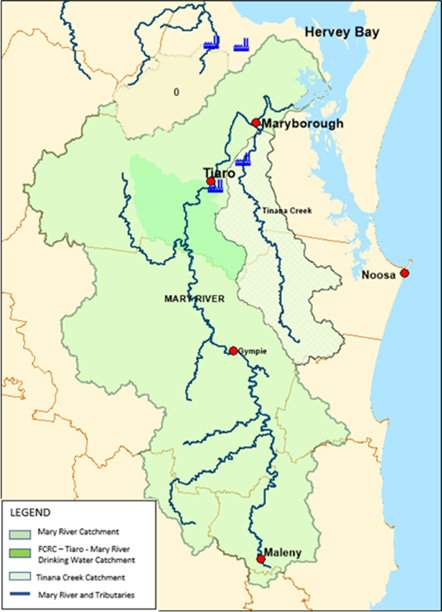
Fraser Coast Drinking Water Catchment Management Strategy
Latest News
-
Lenthall Dam tailwater area to be permanently closed
The Lenthall Dam tailwater area will be permanently closed to keep the community safe.
Fraser Coast Regional Councillor Zane O’Keefe said Lake Lenthall was a fantastic recreational facility for those who enjoy camping, boating, fishing and kayaking, but it was important everyone stayed away from the tailwater area below the spillway.
“Lake Lenthall is stocked with barramundi and Australian bass so is a popular spot for recreational fishing, but a growing number of fishers have been accessing an area immediately downstream of the dam,” he said.
“This area can be dangerous as large volumes of water can be released rapidly when the dam gates operate.
“Council has signs installed highlighting that the area is a no-go zone but unfortunately, some members of the public continue to ignore public safety advice and are willing to risk their lives just to go fishing.
“This reckless behaviour is not on. Council has resolved to permanently close the area below Lenthalls Dam spillway to public access under our local laws so that people who repeatedly enter this area can be issued with fines.
“The closure of a 5.7 hectare section of the area downstream of Lenthalls Dam aligns with what occurs in State Government controlled public waterways, which are generally closed to fishing up to 600 metres downstream of water infrastructure such as dams, weirs and barrages.”
More information about Lake Lenthall, including the rules around camping, boating and fishing in the area, is available here - https://www.frasercoast.qld.gov.au/lake-lenthall
Category : Latest News -
Strategy to maintain healthy drinking water catchments
Fraser Coast Regional Council has adopted a new strategy to support and guide how the region’s drinking water catchments are managed over the next decade.
Cr Darren Everard said three separate catchments supplied the Fraser Coast with drinking water.
“Drinking water catchments are areas where the natural landscape collects rainwater which eventually flows via creeks, rivers and underground systems into drinking water storages, such as dams, weirs and barrages,” he said.
“The Fraser Coast’s drinking water catchment areas are along the Burrum River, the Mary River and Tinana Creek, and maintaining these catchments is vital for ensuring a safe water supply for our community.
“These catchments don’t just provide drinking water though. They also support various land uses, including agriculture, grazing, forestry and residential properties.
“In addition, our drinking water catchments are home to a range of species of plants and animals, provide opportunities for recreation such as boating, fishing and kayaking, and include culturally significant areas like the Wongi Waterholes.”
Cr Everard said the strategy was developed following extensive stakeholder and community consultation, with the community asked what land and water values were most important to them.
“We thank the community for providing feedback, which enabled Council to finalise the strategy and the five key principles to guide how our drinking water catchments will be managed,” he said.
The five principles of the Fraser Coast Drinking Water Catchment Management Strategy are:
- Prioritise through long-term planning and investment;
- Protect through Council and key stakeholder programs and projects;
- Understand and apply through sampling, monitoring, surveillance and research;
- Educate and collaborate through sharing knowledge, resources and projects with the community and key stakeholders;
- Value beyond providing safe and reliable drinking water, focusing on environmental, cultural, social and economic values.
A copy of the Fraser Coast Drinking Water Catchment Management Strategy is available on this engagmeent project page here: https://frasercoast.engagementhub.com.au/drinking-water-catchment in the Document Library, can be dowloaded immediately here: https://frasercoast.engagementhub.com.au/projects/download/15550/ProjectDocument or on the Coucnil's main website at https://www.frasercoast.qld.gov.au/publications.
Category : Latest News -
Thank you for telling us what is important to you about the Fraser Coast's drinking water catchments
Thank you for telling us what is important to you about the Fraser Coast's drinking water catchments
We received hundreds of feedback responses and comments, and are currently reviewing these as we draft our Fraser Coast Drinking Water Catchment Management Strategy.
We hope to have a draft strategy ready for review by our key stakeholders later this year or early 2023.
Category : Latest News -
Have your say on Fraser Coast’s drinking water catchments
Fraser Coast residents are being encouraged to have their say on what they would prefer to see happen in and around the region’s drinking water catchments.
Cr David Lee said there were three separate catchments that supplied the Fraser Coast with drinking water, and Council was looking to determine the community’s priorities around how Council should help manage these catchments.
“Drinking water catchments are areas where rainwater is collected by the natural landscape and eventually flows via creeks, rivers and underground systems into drinking water storages, such as dams, weirs and barrages,” he said.
“The Fraser Coast’s drinking water catchment areas are located along the Burrum River, the Mary River and Tinana Creek.
“These catchments don’t just provide drinking water though. They also support a wide range of land uses, including agriculture, grazing, forestry and residential properties.
“In addition, our drinking water catchments are home to a range of species of plants and animals, provide opportunities for recreation such as boating, fishing and kayaking, and include culturally significant areas like the Wongi Waterholes.
“Maintaining healthy catchments with good quality water is vital for the community and it’s vital for the environment.”
Cr Lee said Council had developed a series of catchment management guiding principles and was asking community members their views on these principles, as well as what land and water values were most important to them.
The five draft principles for the Fraser Coast Drinking Water Catchment Management Strategy are:- Council will prioritise drinking water catchment management actions through long-term planning and investment.
- Council will protect our drinking water catchments through Council run and key stakeholder led programs and projects.
- Council will seek to understand and then apply this understanding of our drinking water catchments through targeted sampling, monitoring, surveillance, and actions.
- Council will educate and collaborate with the community and key stakeholders about drinking water catchment knowledge, resources and projects.
- Council will value our drinking water catchments beyond the provision of safe and reliable drinking water focusing on environmental, cultural, social, and economic values.
Council has developed a Drinking Water Catchment Management page on its Engagement Hub website - https://frasercoast.engagementhub.com.au/drinking-water-catchment - which includes a range of fact sheets and a short online survey.
Council officers will also have copies of the survey to fill out at selected markets throughout the region in coming weeks.
Category : Latest News
Document Library
FAQS
Drinking water catchments are areas where rainwater is collected by the natural landscape and eventually flows via creeks, rivers and underground systems into drinking water storages, such as dams, weirs and barrages.
The Fraser Coast’s drinking water catchment areas are located along the Burrum River, Mary River and Tinana Creek.
A healthy drinking water catchment has large areas of vegetation with productive soils providing lots of opportunities for rainwater to flow overland into creeks and rivers, and to seep into the ground. Healthy vegetation and soils utilise the rainwater as it flows overland and seeps through the ground.
The water eventually flows into drinking water storages such as the Fraser Coast’s dams, weirs and barrages.
Healthy drinking water catchments ensure quality water is available to the environment and the community. Heathy catchments don’t increase the quantity of water available, but they do improve the quality of water available.
For information about securing adequate water supplies to meet growing demand on the Fraser Coast, you’re welcome to read about Council’s Water Security Study here.
Council undertakes drinking water catchment management activities such as
- community education
- fire and hazard reduction management
- management and monitoring of aquatic and environmental weeds
- regular sampling, testing and monitoring of water quality
- vegetation and biodiversity conservation.
Council’s Wide Bay Water and Waste Services Department undertakes drinking water catchment management activities that include:
- regular sampling, testing and monitoring of water quality
- management and monitoring of aquatic and environmental weeds
- fire management and hazard reduction
- vegetation and biodiversity conservation
- community education.
Healthy catchments ensure quality water is available to the environment and the community. Heathy catchments don’t increase the amount of water available, but they do improve the quality of water available. For information about securing adequate water supplies to meet growing demand on the Fraser Coast, you’re welcome to read about Council’s Water Security Study here.
Hervey Bay's (postcodes 4655, 4662, 4659) drinking water is sourced from Lake Lenthall located on the Burrum River.
- Water is channelled from the Lake Lenthall dam through two Burrum River weirs
- then pumped to the Howard and Burgowan Water Treatment Plants, and
- the treated drinking water is stored and supplied to Fraser Coast customers.
Visitors need to be aware that access to Lake Lenthall is via a rough dirt road. The road is controlled and maintained by Forest Products, a business unit of the Queensland Government. Accessing Lake Lenthall is at your own risk and a 4WD is recommended. The Lake Lenthall Ranger will not be able to assist with towing vehicles if they become stuck.

Hervey Bay's drinking water catchment.
Maryborough's (postcode 4650) drinking water is sourced from the Teddington Weir located on Tinana Creek. Tinana Creek is a major tributary of the Mary River.
- Water from the Teddington Weir is pumped to the Teddington Water Treatment Plant
- then the treated drinking water is stored and supplied to Fraser Coast customers

Maryborough's drinking water catchment
Tiaro’s (postcode 4650) drinking water is sourced from the Mary River upstream from the Mary Barrage.
- Water from the Mary River is pumped to the Tiaro Water Treatment Plant
- then the treated drinking water is stored and supplied to Fraser Coast customers.

Tiaro’s drinking water catchment
To keep the Fraser Coast’s drinking water catchments healthy Council’s drafted these Principles.
- Council will prioritise drinking water catchment management actions through long-term planning and investment.
- Council will protect our drinking water catchments through Council run and key stakeholder led programs and projects.
- Council will understand and apply this understanding in our drinking water catchments through targeted sampling, monitoring, surveillance, and research actions.
- Council will educate and collaborate with the community and key stakeholders about drinking water catchment knowledge, resources and projects.
- Council will value our drinking water catchments beyond the provision of safe and reliable drinking water focusing on environmental, cultural, social, and economic values.








